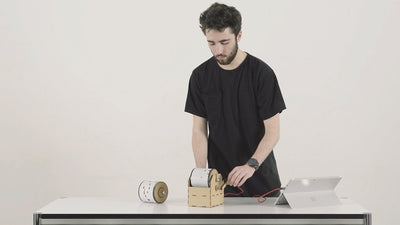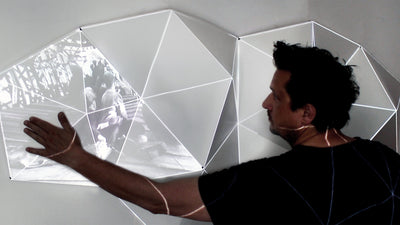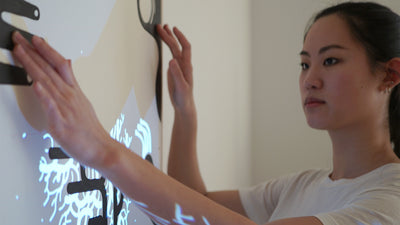Mural Interactivo - Creating An Interactive Mural Within A Workshop

The Interactive Mural project started as an art workshop back in 2016 and continued as a workshop series in 2017. It involved a network of young people from all over Mexico City, in collaboration with the "Faros", Fabrica de Artes y Oficios, (Art and Crafts Factory) - a project that promotes creative cultural activities in areas that are affected by social exclusion.
The workshop was based on three conceptual axes: technology, art and community. Mexico City was the starting point, establishing a link between communities in 5 areas of the city, located in strategic and decentralised geographic points: Oriente, Aragon, Tlahuac, Milpa Alta and Indios Verdes.
The workshop started with the basic principles of electronics; What is an LED? What are electronics? What is conductivity? What is resistance? They then shared examples that they made themselves, using graphite as a conductive material. They made light sensitive stickers through the use of transistors and even made an oscillator that translated variations in resistance into audio.
The group learned the basic principles of programming, first in Scratch and later in Arduino. They also learned to use commercial electronic boards, such as OTOTO, Makey-Makey and Arduino, and then the Bare Conductive Touch Board.
All programming and circuits seen were made with soft conductive materials, such as copper tape and Electric Paint.
Visual concepts, such as composition, space and visual development, of an idea were then considered. They were taught how to make basic animations, as well as how to use VJ software, Resolume Arena, which was used to map and project on to the mural.
The final exercise of the workshop was the production of an interactive mural, bringing all the knowledge together. This involved linking traditional techniques, such as painting, with electronic and programming technologies, creating a hybridisation in media that expanded the possibilities of expression.
Once the technical side of the project was developed, the discussion turned to what the mural would portray. Given the general topics and themes of social exclusion and shared knowledge among residents of the areas, they decided to focus on micro-stories within the community.
The result is five, fully functional, touch-sensitive interactive murals that react with sound and video mapping projections, portraying a global vision of the different areas of Mexico City, on topics such as water, informal commerce, traditions, among others.
This project is devised in Laboratorio de Ciudadania Digital, a program created in 2014 by the Centro Cultural de Espana en Mexico y Fundacion Telefonica Mexico. Within the LCD organisation, culture, science, art and technology are considered as a means for building knowledge and community, hence the importance of linking these to the graphics within the digital and interactive narratives.
Faro Tláhuac
Although these old lacustrine zones still conserve chinamperas zones and wetlands, problems like the lack of water supply and the contamination of drinkable water affect the population of this region.
The line in blue joins all those small microhistories, to visualise a map of Tláhuac, because, for the people there, water is a social and historical connector; a common denominator that is present and unites all that live there.
Faro Aragón
When people talk about the history of technology, they also talk about the history of humanity. An example of this can be seen in all the technological devices we use today; what would computers be like today if the wheel had never been invented? There is, also, the knowledge that is passed from generation to generation. This mural presents a series of everyday objects that, in different historical times, have created what each of us is today.
Faro Milpa Alta
Milpa Alta is one of the rural areas of the city, which holds some urban characteristics. People living there believe in the importance of preserving day to day traditions, like for example, the treatment of the milpas, the morphology of a teporingo, or the legend of Juan Carnero, among others; because part of this knowledge is now unknown to some inhabitants of the Mexico City.
Faro Indios Verdes
This interactive mural uses a tree to symbolise the history of the Faro. They relate to certain elements of the flora and fauna native to this region. In addition to the historical elements of the construction of the Faro, they also added shoes, to allude to the old factory on which the Faro was built. In the treetop are stories of the current community, symbolising a growing community.
Faro Oriente
The figure of the market on wheels plays a crucial role in the history of Mexico City. In Faro de Oriente, the team decided to portray a series of objects that refer to the tianguis of "El Salado", not only because of its importance in their production, but also because of the symbolic strength of all the goods that arrive there. They're interested in showing those technological objects that have been forgotten, that have lost their common use, that have passed through many hands, and that now seem as if they were a sample of fossils. The piece alludes to older technology that has been forgotten, but has inspired many other products.
Images & Video: Laboratorio de Ciudadanía Digital
If you want to create your own Projection Mapping project, have a look at the tutorial with the Touch Board or the tutorial with the Pi Cap.
We love it when you share your projects! Post your project on Instagram, YouTube, or Twitter, and make sure to tag @bareconductive or use #bareconductive. You can also send your videos and photos to info@bareconductive.com so we can post them on our site for the world to see.







